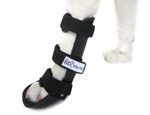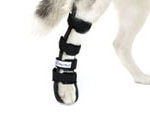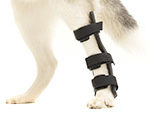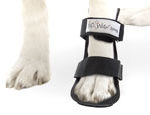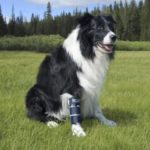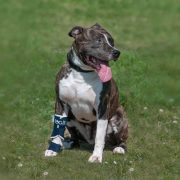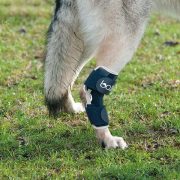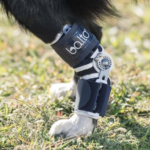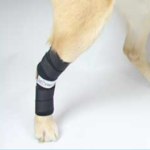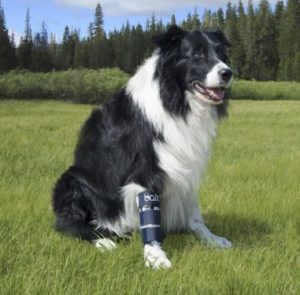 | These splints will help support injuries in the lower limbs including the hock joint, carpal joint, and the paw. For injuries in other areas of the limbs or other parts of the body, return to our main splints page. |
Designed to extend completely under the foot. The Front limb splints will support the Paw, the Carpal (“wrist”) joint and extend to mid-forearm. The Splints will not support injuries to the animals Elbow or Shoulder.
| What will the Front Leg Splint support? | |||
| Front Leg | Y | Rear Leg | N |
| Carpal/Wrist | Y | Hock/Ankle | N |
| Elbow | N | Stifle/Knee | N |
| Front Paw | Y | Rear Paw | N |
A light weight brace designed to support the carpal joint. Ideal for tendon and ligament damage and stabilization after surgical procedures.
| What will the Carpal Splint support? | |||
| Front Leg | Y | Rear Leg | N |
| Carpal/Wrist | Y | Hock/Ankle | N |
| Elbow | N | Stifle/Knee | N |
| Front Paw | N | Rear Paw | N |
Designed to support the rear paw, and the lower aspect of the rear limb. Extends up and over the Hock or Heel of the animal. These Splints do extend completely under the foot.
| What will the Rear Limb Splint support? | |||
| Front Leg | N | Rear Leg | Y |
| Carpal/Wrist | N | Hock/Ankle | Y |
| Elbow | N | Stifle/Knee | N |
| Front Paw | N | Rear Paw | Y |
Accommodate injuries to the heel and stabilize the lower limb while keeping the paw free. This type of splint will support a variety of tendon and ligament issues.
| What will the Rear Hock Splint support? | |||
| Front Leg | N | Rear Leg | Y |
| Carpal/Wrist | N | Hock/Ankle | Y |
| Elbow | N | Stifle/Knee | N |
| Front Paw | N | Rear Paw | N |
Support the lower aspect of the rear or front limb. This brace extends under the paw for knuckling problems and digit injuries.
| What will the Bootie Splint support? | |||
| Front Leg | Y | Rear Leg | Y |
| Carpal/Wrist | N | Hock/Ankle | N |
| Elbow | N | Stifle/Knee | N |
| Front Paw | Y | Rear Paw | Y |
Comes with three rigid splints – one fixed splint contained in a pocket on the centre back and two side splints with Velcro backing which allows them to be positioned as needed for optimum effectiveness.
| What will the Front Leg Brace support? | |||
| Front Leg | Y | Rear Leg | N |
| Carpal/Wrist | Y | Hock/Ankle | N |
| Elbow | N | Stifle/Knee | N |
| Front Paw | N | Rear Paw | N |
The brace is specially designed to support the radio-carpal, metacarpal and tarsometatarsal joints.
| What will the Instability Brace support? | |||
| Front Leg | Y | Rear Leg | Y |
| Carpal/Wrist | Y | Hock/Ankle | N |
| Elbow | N | Stifle/Knee | N |
| Front Paw | Y | Rear Paw | Y |
This brace is used in conditions that cause lesions in the region of the hock joint, with symptoms such as pain, lameness or difficulty in moving.
| What will the BT Hock Brace support? | |||
| Front Leg | N | Rear Leg | Y |
| Carpal/Wrist | N | Hock/Ankle | Y |
| Elbow | N | Stifle/Knee | N |
| Front Paw | N | Rear Paw | N |
The balto brace FLEXOR has been developed to give stability to canine tarsal joints in the event of traumatic or congenital instability.
| What will the BT Flexor Brace support? | |||
| Front Leg | N | Rear Leg | Y |
| Carpal/Wrist | N | Hock/Ankle | Y |
| Elbow | N | Stifle/Knee | N |
| Front Paw | N | Rear Paw | N |
The carpal brace is used for conditions involving lesions to the carpus, leading to pain, lameness, or difficulty in moving.
| What will the Carpal Brace support? | |||
| Front Leg | Y | Rear Leg | N |
| Carpal/Wrist | Y | Hock/Ankle | N |
| Elbow | N | Stifle/Knee | N |
| Front Paw | N | Rear Paw | N |
A comfortable wrap to help support the hock joint – Found on a dog’s back leg below the knee. This joint corresponds to the ankle on a human. These wraps are suitable for mild – moderate support, but do not support as firmly as the rigid splints above.
| How will the Hock Wrap help my dog? | |
Designed to fit the natural angle of the Hock | Supports the joint Medially and Laterally |
Prevents over extension of the Hock joint | Lessens strain on the Hock joint |
A comfortable hugger wrap to help support the hock joint – Found on a dog’s back leg below the knee. This joint corresponds to the ankle on a human. These hugger wraps are suitable for mild – moderate support, but do not support as firmly as the rigid splints above.
| How will the Hock Wrap help my dog? | |
Designed to fit the natural angle of the Hock | Supports the joint Medially and Laterally |
Prevents over extension of the Hock joint | Lessens strain on the Hock joint |
Fitted directly above each paw, the wrist hugger lends support to the muscles and tendons of the wrist and leg. These wraps are suitable for mild – moderate support, but do not support as firmly as the rigid splints above.
| How will the Wrist Wrap help my dog? | |
Stabilizes your dog’s forearm bones | Lends support to the muscles and tendons of the wrist and leg |
Made from a comfortable Neoprene | When secured properly, does not interfere with the flexion of the paw |
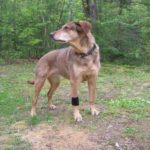 The Walkin’ Wrist Wrap
The Walkin’ Wrist Wrap
Your dog’s front legs are much like your own arms. Fitted securely directly above each paw the wrist joint stabilizes your dog’s forearm bones and lends support to the muscles and tendons of the wrist and leg.
| How will the Wrist Wrap help my dog? | |
Designed to stabilize the Carpal Joint | Supports the joint Medially and Laterally |
Prevents over extension of the Carpal joint | Lessens strain on the Carpal joint |
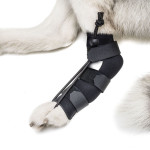 The Walkin’ No-Knuckling Training Sock
The Walkin’ No-Knuckling Training Sock
A lightweight, comfortable and convenient training support for dogs who are dragging their front and back paws. Designed to enhance the proprioceptive reflex and are available in five sizes for a perfect fit.
| How will a No-Knuckling Sock help my pet? | |
| Provides training support for a dog dragging paws | Designed to enhance proprioception (pet’s sense of own movement) |
| Perfect for rehabilitative use for pets that are recovering from spinal surgery | Helps correct gait and improve paw placement |
BT PULL – BRACE FOR HYPERFLEXION PHALANGES
The brace can be used for neurological disorders that cause severe proprioceptive deficits, which mean that the dog is unable to sense the position of the limb on the ground, thus tending to stand on the back of its paw (dorsiflexion).
| How will a BT PULL Brace help my pet? |
| Neurological disorders causing dragging of the back legs |
| Proprioceptive deficits |
| Prevent shortening of the flexor tendons |

